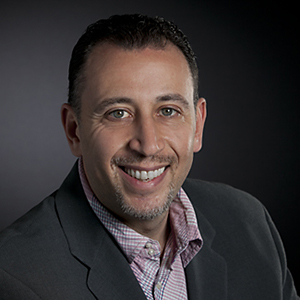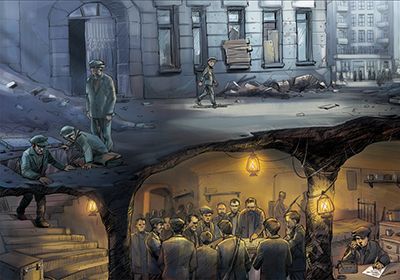
Alex Teplish
Teplish drew on his grandfather’s testimony in the Visual History Archive to tell the story of how Aron survived the Holocaust as a child in the Soviet Union in Survivor: Aron’s Story, available now on Amazon. The first half of the book is in the form of a graphic novel, with Aron’s story told through comic book-style illustrations, and the second half provides more background and historical context about the Holocaust in the Soviet Union.
[[nid:10177]]
Aron lived in a working-class neighborhood of Odessa, Ukraine, with his siblings and parents. Once the war started, they had to survive the Romanian occupation of the city and then were arrested and deported. His parents died after being forced to work on a farm with no food, clothing or medicine. Aron and his siblings survived the brutal two and a half years of forced labor, killings, starvation and disease, and went on to marry and have families of their own. Aron died in 2012.
Teplish was born in Odessa and immigrated to the United States with his parents and grandparents at two years old. He grew up very close to his grandparents and heard his grandfather’s stories about the Holocaust often.
Re-watching his grandfather’s testimony as an adult, Teplish was amazed that Aron could still remember such vivid details, and he was impressed by Aron’s resiliency. Aron had wanted to tell his story to more people and entrusted his testimony with his grandchildren.
“Now it’s our turn to share his story and carry on his legacy,” Teplish said.
Teplish began working on a graphic novel about Aron as part of the COJECO BluePrint Fellowship, which provides grants for Jewish community events. Teplish had already written one science fiction graphic novel and knew that telling his grandfather’s story of survival in the same way could teach people about the Holocaust who would not normally be exposed to it.
“A high school student isn’t necessarily going to pick up a 300 page novel about someone’s experience of the Holocaust, but a graphic novel is something that’s more appealing to a younger audience,” Teplish said. “As I’ve been working on it I’ve realized a lot of places in the United States don’t teach this, and when you leave the US there are people in some countries who have no idea [the Holocaust] even took place. This kind of book is easy to pick up and read through and learn about this subject.”

It was fascinating to work on the book with the Romanian artists, Teplish said, since so much of his grandfather’s suffering had been at the hands of the Romanian army. The artists told him how meaningful and educational it was to work on the project since they had never learned about these atrocities before.
The book came together in about eight months, supported by a crowd-funding campaign and other grants in addition to COJECO. Teplish has also created a multimedia presentation about the book that he hopes to take to schools and community centers.
He hopes Survivor: Aron’s Story opens readers’ eyes to the experiences of people who have been through the Holocaust and other crimes against humanity. The fact that genocides have happened all over the world, to people from all walks of life, should unify us, not separate us, he said.
“These kinds of situations don’t just happen out of nowhere, they build up over many years and they could happen again,” he said. “By learning about history you can recognize situations like that and prevent them from escalating.”